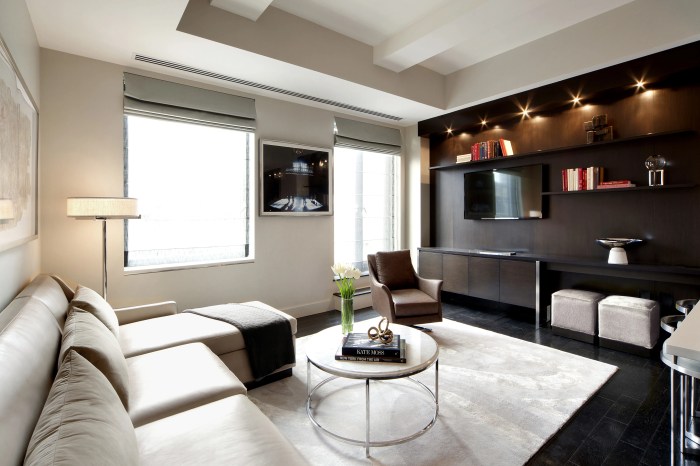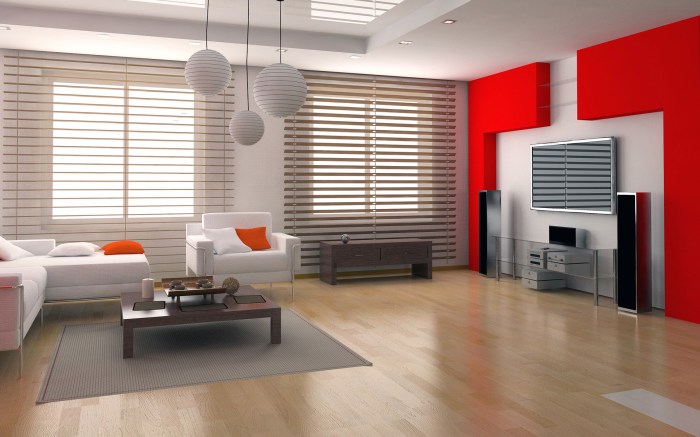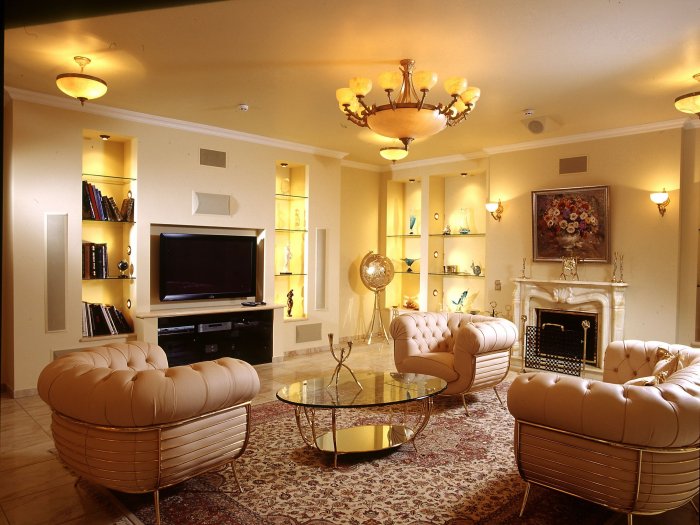Crafting the Perfect Room Interior: A Guide to Creating Your Dream Space
Room interior is where style meets functionality, where every element plays a crucial role in shaping the ambiance of a space. From furniture arrangement to color schemes, every detail matters in transforming a room into a personalized sanctuary. Dive into the world of room interior with us as we explore the key components that make a space truly unique.
In this guide, we will delve into the essential elements that contribute to a well-designed room interior, the impact of color schemes on mood, the art of furniture arrangement, the role of decorative accessories, and the importance of flooring and wall treatments in creating a cohesive look.
Get ready to unleash your creativity and transform your space into a haven of comfort and style.
Elements of Room Interior

When designing a room interior, several elements come into play to create a cohesive and visually appealing space. These elements include furniture, lighting, color scheme, texture, and accessories.
Lighting
Lighting is a crucial element in enhancing the overall look and feel of a room interior. Proper lighting can create ambiance, highlight key features, and even make a space appear larger. Different types of lighting, such as ambient, task, and accent lighting, can be used to add depth and dimension to a room.
Furniture
Furniture plays a significant role in defining the style and functionality of a room. The choice of furniture pieces, their arrangement, and the materials used can all impact the overall design aesthetic. Whether you prefer a modern, minimalist look or a cozy, traditional feel, selecting the right furniture is essential in creating a space that reflects your personal style.
Color Schemes
When it comes to room interiors, color schemes play a crucial role in setting the tone and ambiance of the space. Different color combinations can evoke various emotions and moods, making it essential to choose the right palette for the desired effect.
Additionally, natural light can significantly impact how colors are perceived within a room, influencing the overall atmosphere.
Popular Color Schemes
- Monochromatic: This color scheme involves using variations of a single color, creating a harmonious and soothing effect. For example, different shades of blue can evoke a sense of calmness and serenity in a room.
- Analogous: Analogous color schemes consist of colors that are next to each other on the color wheel, such as blue and green. These schemes are pleasing to the eye and create a sense of unity and cohesiveness.
- Complementary: Complementary colors are opposite each other on the color wheel, like blue and orange. This scheme provides a vibrant and dynamic look, with colors that enhance each other when paired together.
Mood Elevation through Color Schemes
- Warm Colors: Shades like red, orange, and yellow can create a cozy and inviting atmosphere, perfect for social spaces like living rooms or dining areas.
- Cool Colors: Colors like blue, green, and purple are known for their calming and refreshing qualities, making them ideal for bedrooms or home offices where relaxation is key.
- Neutral Colors: Whites, grays, and beiges are versatile and timeless, providing a sense of balance and sophistication to any room.
Impact of Natural Light
When natural light filters into a room, it can affect the way colors appear. Rooms with ample sunlight may showcase colors more vibrantly, while spaces with limited light may make colors appear duller or darker. It's essential to consider the orientation of windows and the amount of light a room receives when selecting color schemes to achieve the desired look and feel.
Furniture Arrangement

When it comes to optimizing furniture arrangement in a room, there are several key tips to keep in mind. The placement of furniture can greatly impact the functionality and aesthetics of a space, so it's important to carefully consider how each piece fits within the layout.
Additionally, achieving balance and symmetry in furniture arrangement can enhance the overall look and feel of a room.
Importance of Furniture Arrangement
Proper furniture arrangement is essential for creating a harmonious and functional space. By strategically placing furniture, you can maximize the use of the room while maintaining a sense of openness and flow. It's crucial to consider the size and scale of each piece to ensure that they complement each other and the overall layout of the room.
- Ensure that there is enough space for easy movement around the furniture.
- Consider the function of the room and arrange furniture accordingly (e.g., seating areas in a living room).
- Pay attention to traffic flow and ensure that there are clear pathways throughout the room.
- Group furniture pieces together to create cozy conversation areas or separate zones within a larger space.
Balance and Symmetry in Furniture Layout
Achieving balance and symmetry in furniture layout involves distributing visual weight evenly throughout the room. This can help create a sense of harmony and order, making the space more visually appealing.
- Use pairs of matching furniture pieces to create symmetry in a room.
- Balance large, heavy pieces with lighter elements to avoid a lopsided look.
- Consider the placement of furniture in relation to architectural features such as windows and doors.
- Experiment with different furniture arrangements to find the most pleasing and functional layout.
Decorative Accessories
Decorative accessories play a crucial role in enhancing the overall look and feel of a room. They add personality, style, and character to the space, making it more inviting and visually appealing.
Textures are essential in adding depth to room decor. They can create visual interest, contrast, and dimension, making the room feel more dynamic and layered. Textures can be incorporated through various decorative accessories such as rugs, throw pillows, curtains, and wall art.
Common Decorative Accessories
- Throw pillows and blankets
- Rugs and carpets
- Curtains and drapes
- Wall art and mirrors
- Vases and decorative bowls
- Candles and candle holders
Importance of Personal Style
Decorative accessories offer a great opportunity to showcase personal style and preferences in a room. By choosing accessories that resonate with your taste, interests, and experiences, you can create a space that feels uniquely yours. Whether it's through bold colors, eclectic patterns, or sentimental items, decorative accessories can reflect who you are and what you love.
Flooring and Wall Treatments
When it comes to room interiors, flooring and wall treatments play a crucial role in setting the overall tone and style of the space. Choosing the right materials for flooring and the appropriate wall treatments can make a significant impact on the look and feel of the room.
Types of Flooring Materials
- Hardwood: Known for its durability and timeless appeal, hardwood flooring adds warmth and elegance to any room.
- Laminate: A cost-effective alternative to hardwood, laminate flooring is easy to maintain and comes in a variety of styles that mimic natural materials.
- Tile: Ideal for high-traffic areas, tile flooring is durable, water-resistant, and available in a wide range of colors and patterns.
- Carpet: Soft and cozy, carpet flooring provides comfort underfoot and helps to reduce noise in the room.
Impact of Wall Treatments
- Paint: Choosing the right paint color can instantly transform the mood of a room. Light colors can make a space feel larger, while dark colors add a sense of coziness.
- Wallpaper: Wallpaper allows for endless design possibilities, from bold patterns to subtle textures, creating a focal point in the room.
- Textures: Adding texture to walls through techniques like stucco, wood paneling, or faux finishes can enhance the visual interest and depth of the space.
Coordinating Flooring and Wall Treatments
- Consider the overall style and color scheme of the room when selecting flooring and wall treatments to ensure a cohesive look.
- Aim for a balance between the flooring and wall treatments – if one is busy or bold, the other should be more neutral to avoid overwhelming the space.
- Use flooring and wall treatments to create a sense of flow and continuity throughout the room, connecting different elements of the design.
Final Summary

As we conclude our journey through the realm of room interior, remember that the magic lies in the details. By carefully selecting each element, from colors to textures to furniture placement, you have the power to turn a simple room into a reflection of your personality and taste.
Let your imagination run wild and watch as your dream space comes to life before your eyes.
Questions and Answers
What role does lighting play in room interior design?
Lighting is crucial in enhancing the ambiance of a room. It can highlight key features, create a cozy atmosphere, and even affect the perception of colors.
How can I optimize furniture arrangement in a small room?
To maximize space in a small room, consider using multi-functional furniture, utilizing vertical space, and keeping pathways clear for easy movement.
Why are textures important in room decor?
Textures add depth and visual interest to a room, creating a more dynamic and inviting space. They also help in balancing different design elements.




